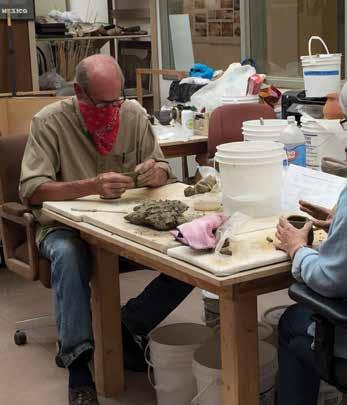
2 minute read
OFFICE OF ARCHAEOLOGICAL STUDIES
FY2020-2021 A POTPOURRI OF ACTIVITIES
Not just another pretty plant |
The Walk Through Time Garden was launched at the Center for New Mexico Archaeology in FY2021, providing an educational purpose for landscaping. Unlike most botanical gardens, it shows that beauty lies in the functions and historic roles of plants more than in color and form. Specialty perennials like yucca (basketry and fiber), sumac (beverages, dyes and basketry materials) and Apache plume (arrow shafts) grow alongside more familiar edibles such as currants, chokecherries and wild plums. This ambitious project will be a work in progress for years to come.
Left: The Walk Through Time Garden features terraces crafted by retired Office of Archaeological Studies archaeologist Vernon Foster (Navajo/Diné). These help spread and hold water harvested from the roof of the Center for New Mexico Archaeology, increasing the diversity of environments around the building for both cultivated and natural plantings. Photo by Saro Calewarts.
60 programs reaching 1,104 children and 1,157 adults 5 programs delivered directly to Native American communities 1,200+ activity kits distributed statewide 20 new client projects 175 archaeomagnetic dating specimens, 1,787 measurements 128 Radiocarbon samples dated $50,000 exhibitions and education support $32,000 grants funded $139,000 total private support
—Mollie Toll, Ethnobotanist and Educator, Office of Archaeological Studies, Fall 2020
Right: A mythical “Fantastic Beast” imagined by a student engaged in an at-home project from the Office of Archaeological Studies.


Colorful research | In the spring of 2021, Office of Archaeological Studies staff and volunteers visited a Navajo pictograph panel where one image included a uniquely blue pigment. Bob Florek undertook non-destructive analysis of the background and paint using portable X-ray fluorescence. No trace of copper, a common source of blue and blue-green colors in mineral pigments, was detected. Project archaeologist Chuck Hannaford remarked, “As usual, science provided an answer leading to a host of unexpected questions.” Kids dig it | Creating your own “Fantastic Beasts” was just one of the at-home learning activities designed in FY2021 by Office of Archaeological Studies educators. Students learn functional adaptations of animal body parts and then let their imaginations run wild.

Above left: Portable X-ray fluorescence instruments, which allow compositional studies in the field without risking damage to images or objects, are ideal for studying fragile pictographs. Above right: More than a dozen volunteers made 600 pots for the 200 “Making and Breaking Pots” education kits distributed throughout New Mexico. Photos courtesy Office of Archaeological Studies.










